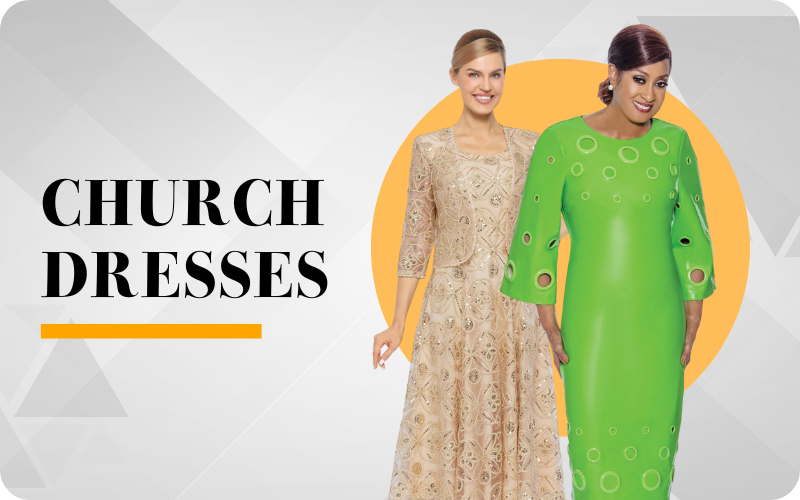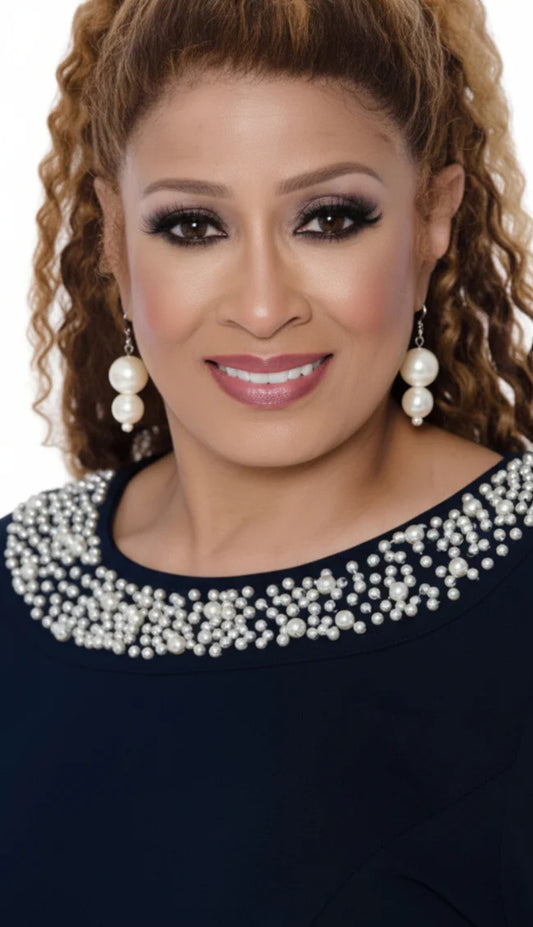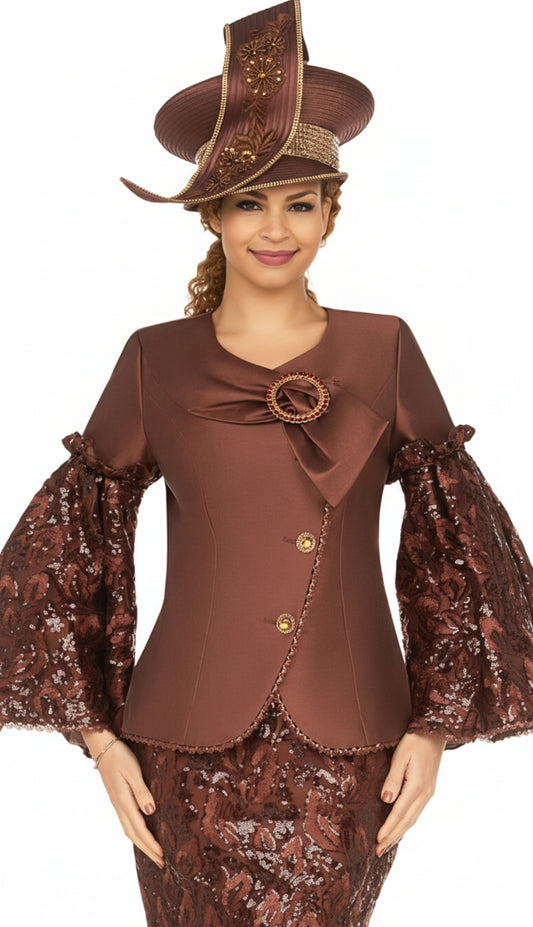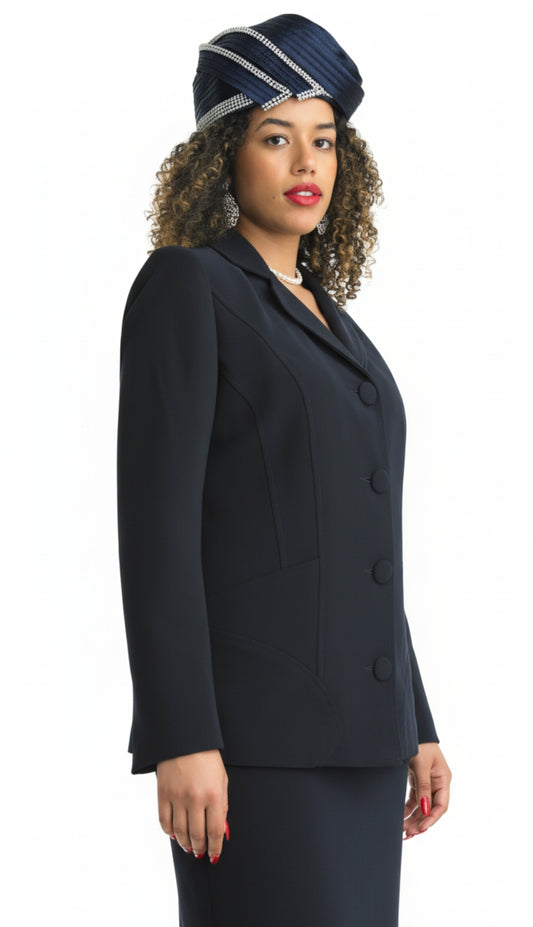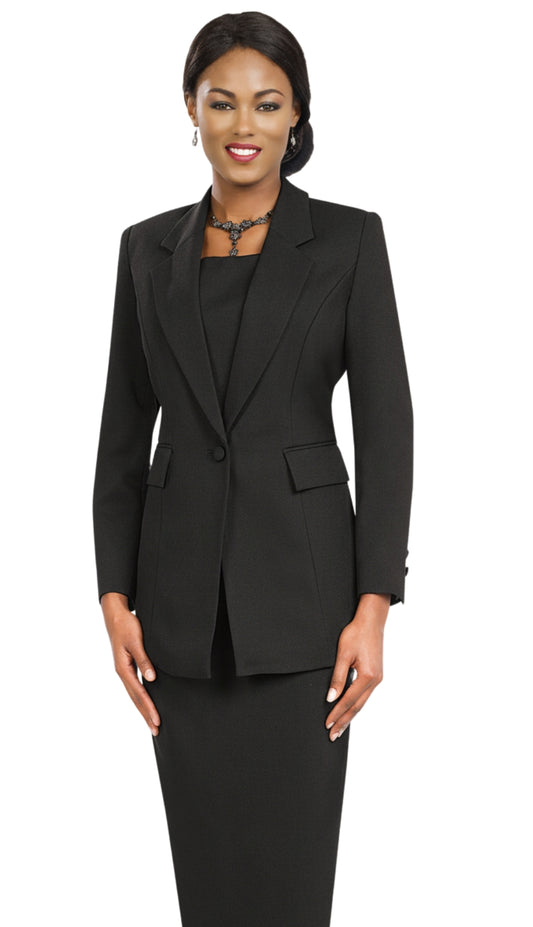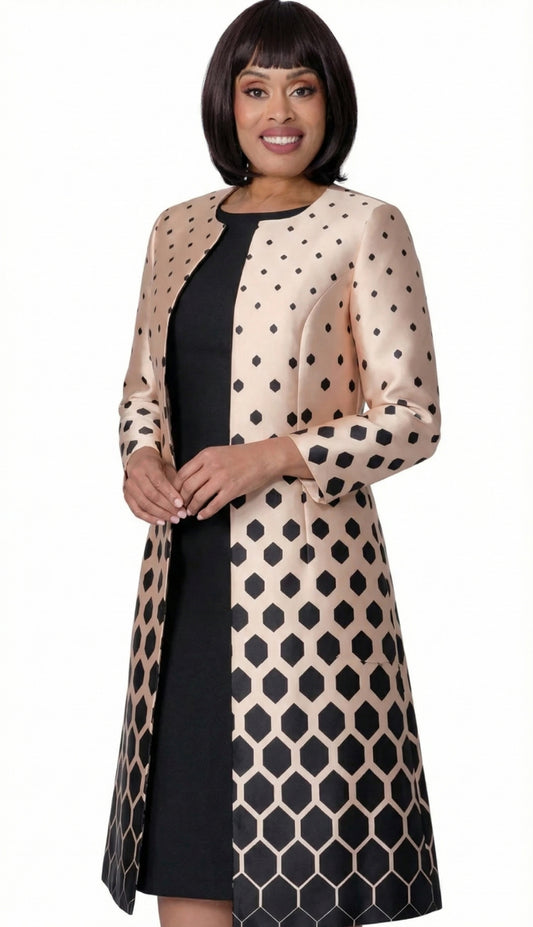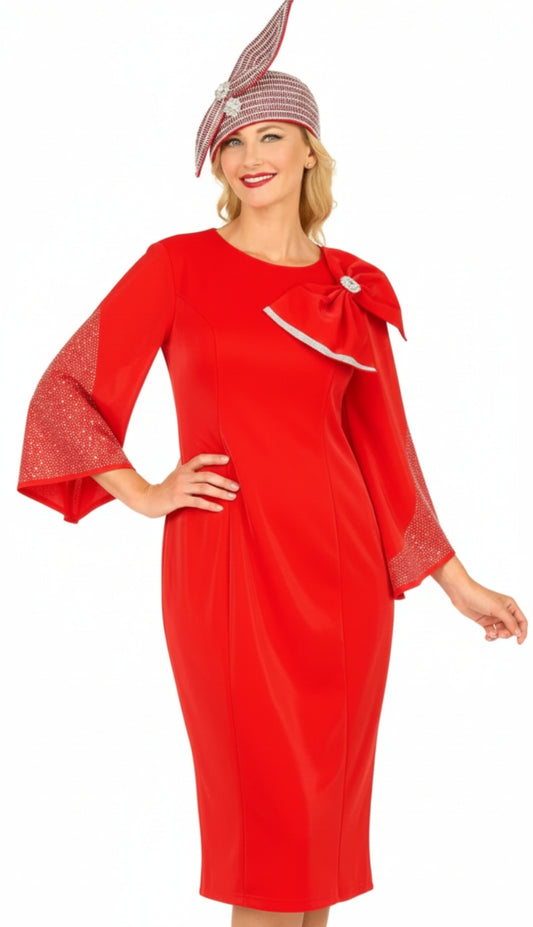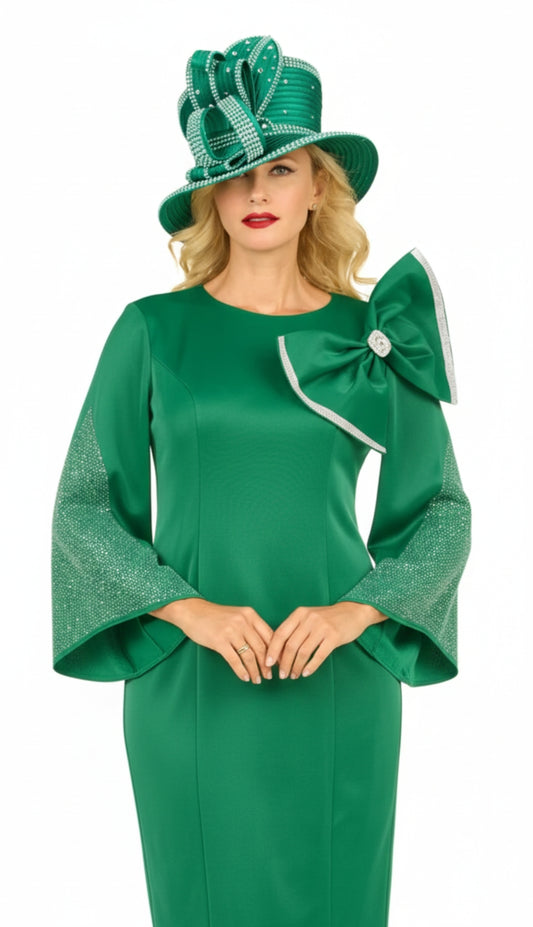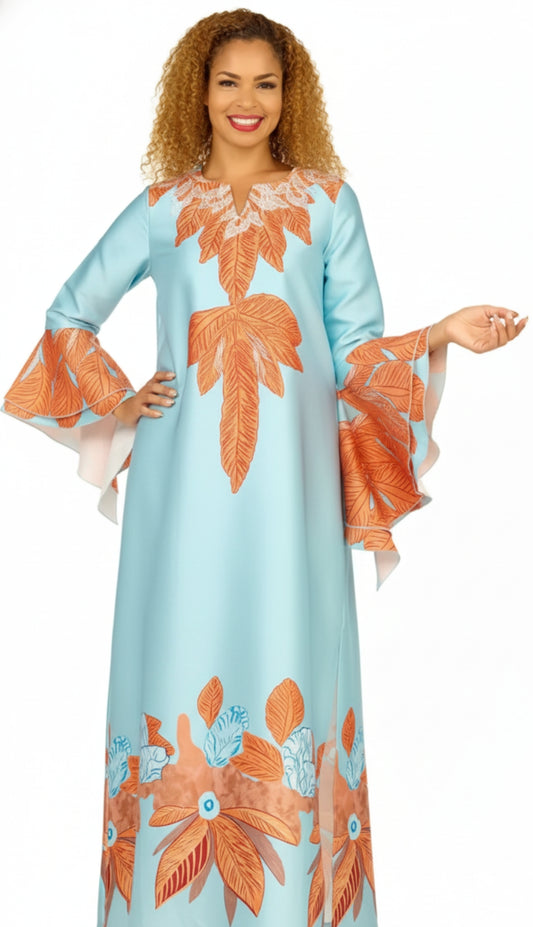
Trending Fast Ship Products - Same Day Shipping
-
GMI G400772-QS Church Suit
Regular price $129.00Regular priceUnit price / per$179.00Sale price $129.00Sale -
Dorinda Clark Cole 309612-NVY-QS Church Suit
Regular price $169.00Regular priceUnit price / per$229.00Sale price $169.00Sale -
Giovanna G1304-CHC-QS Church Suit
Regular price $174.99Regular priceUnit price / per$234.99Sale price $174.99Sale -
Lily And Taylor 3049-NVY-QS Church Suit
Regular price $189.00Regular priceUnit price / per$269.00Sale price $189.00Sale -
Ben Marc 2295-BLK-QS Church Suit
Regular price From $119.00Regular priceUnit price / per$159.00Sale price From $119.00Sale
Trending Sale Products
-

Diana Couture 9098-CO Church Suit
Regular price $169.00Regular priceUnit price / per$229.00Sale price $169.00Sale -

Ben Marc 2296-SIL-CO Church Suit
Regular price $129.00Regular priceUnit price / per$179.00Sale price $129.00Sale -

Giovanna 0707-NVY-CO Church Suit
Regular price From $109.00Regular priceUnit price / per$149.00Sale price From $109.00Sale -

Giovanna 0710-NV-CO Church Suit
Regular price $129.00Regular priceUnit price / per$139.00Sale price $129.00Sale -

Terramina 7025-CHM-CO Church Suit
Regular price $179.00Regular priceUnit price / per$239.00Sale price $179.00Sale
Trending Church Suits
-
Mia By Giovanna G1321 Church Suit
Regular price From $179.00Regular priceUnit price / per$239.00Sale price From $179.00Sale -
Mia By Giovanna G1319-NVY Church Suit
Regular price From $179.00Regular priceUnit price / per$239.00Sale price From $179.00Sale -
Mia By Giovanna G1319-CHC Church Suit
Regular price From $179.00Regular priceUnit price / per$239.00Sale price From $179.00Sale -
Elite Champagne 6266-RED Church Suit
Regular price From $219.00Regular priceUnit price / per$299.00Sale price From $219.00Sale -
Elite Champagne 6264-RED Church Suit
Regular price From $239.00Regular priceUnit price / per$319.00Sale price From $239.00Sale
Trending Church Dresses
-
Giovanna DP2443-PUR Church Dress
Regular price $149.00Regular priceUnit price / per$199.00Sale price $149.00Sale -
Nubiano 100702-IH Church Dress
Regular price From $159.00Regular priceUnit price / per$219.00Sale price From $159.00Sale -
Giovanna DP2445-RED Church Dress
Regular price From $139.00Regular priceUnit price / per$189.00Sale price From $139.00Sale -
Giovanna DP2445-GRN Church Dress
Regular price From $139.00Regular priceUnit price / per$189.00Sale price From $139.00Sale -
Giovanna DP2442 Church Dress
Regular price $129.00Regular priceUnit price / per$179.00Sale price $129.00Sale
Trending Church Hats
-
Dorinda Clark Cole 400943-RED-H-IH Church Hat
Regular price $112.99Regular priceUnit price / per$152.99Sale price $112.99Sale -
Lily And Taylor H418-MAU-IH Church Hat
Regular price $129.00Regular priceUnit price / per$179.00Sale price $129.00Sale -
Lily And Taylor H981-BLK-IH Church Hat
Regular price $129.00Regular priceUnit price / per$179.00Sale price $129.00Sale -
Lily And Taylor H981-IH Church Hat
Regular price $129.00Regular priceUnit price / per$179.00Sale price $129.00Sale -
Lily And Taylor H129-IH Church Hat
Regular price $129.00Regular priceUnit price / per$179.00Sale price $129.00Sale
Recent Articles
View All-
What church suits are appropriate for different...
Going to church is more than just a weekly routine, it's a special time for worship, community, and devotion. For many people, especially women, what they wear to church is...
What church suits are appropriate for different...
Going to church is more than just a weekly routine, it's a special time for worship, community, and devotion. For many people, especially women, what they wear to church is...
-
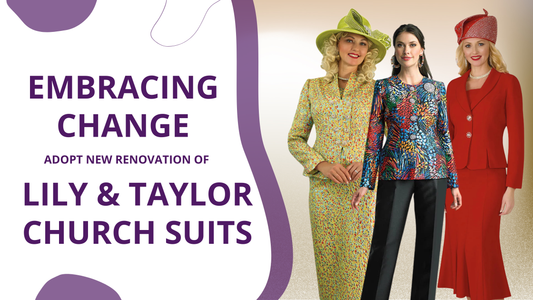
Embracing Change: Adopt New Renovation of Lily ...
Fashion evolves gracefully. It reflects culture, emotion, and purpose — merging tradition with transformation. Among the many brands that have successfully maintained this balance, Lily & Taylor shines as a...
Embracing Change: Adopt New Renovation of Lily ...
Fashion evolves gracefully. It reflects culture, emotion, and purpose — merging tradition with transformation. Among the many brands that have successfully maintained this balance, Lily & Taylor shines as a...
-
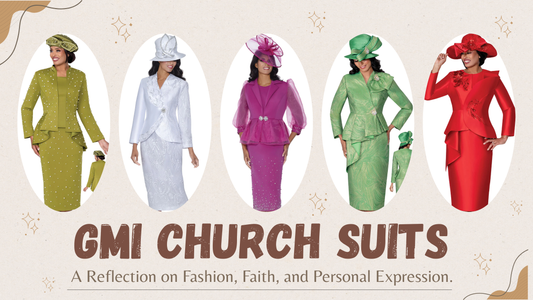
GMI Church Suits : A Reflection on Fashion, Fai...
When people think of fashion, they usually imagine runways, fancy stores, or new trends. But many important fashion choices happen in everyday life, where personal beliefs, faith, and traditions influence...
GMI Church Suits : A Reflection on Fashion, Fai...
When people think of fashion, they usually imagine runways, fancy stores, or new trends. But many important fashion choices happen in everyday life, where personal beliefs, faith, and traditions influence...
Welcome To Church Suits Fast
Church Suits Fast – where divine style meets divine service. Our mission is simple: to clothe you in elegance and grace with the finest selection of church suits, dresses, and hats, delivered to your doorstep with unprecedented speed. With Church Suits Fast, waiting is a thing of the past. Our extensive in-house selection means your perfect outfit is ready to ship the moment you click 'order.' Experience the fusion of heavenly fashion and earthly efficiency. Your Sunday best, delivered faster than a prayer.
Church Suits: A Celebration of Tradition, Style, and Faith
What Are Church Suits? Church suits are elegant, coordinated skirt or pant suits traditionally worn by women to Sunday services and other church events. They are especially beloved in African American communities, where dressing in one’s “Sunday Best” is a longstanding cultural practice. These outfits typically include a beautifully tailored suit—often with matching accessories like a hat, gloves, and refined jewelry—creating a polished head-to-toe look. For many African American women, the church suit is more than just clothing; it’s a symbol of respect, devotion, and cultural pride. This tradition traces back over a century, rooted in the idea that one should present their very best self in the house of worship. During the era of slavery, Sunday worship was one of the few occasions when Black Americans could shed work clothes and don fine attire, giving rise to the concept of wearing one’s “Sunday Best.” Enslaved people often reserved their one good outfit exclusively for church as an act of reverence toward God and a quiet assertion of their dignity (The ‘Sunday Best’ Sartorial Tradition: An Explainer | Service95) ations, this practice evolved into a cultural cornerstone. Church attire became a form of self-expression and empowerment – a weekly event to celebrate personal style and uplift the spirit. In fact, the church sanctuary itself has been affectionately dubbed the community’s first fashion runway. As one essayist noted, the Black church was “the first fashion week,” one of the earliest spaces where Black women could freely showcase their creativity, elegance, and individuality through style. In short, (Easter Sunday Fashion Is Black Culture - Essence | Essence) are not only about looking polished; they honor a rich heritage and deep-seated belief that fashion and faith can go hand in hand.
Historical & Cultural Significance
From Early 20th Century to Today: The tradition of dressing up for church in the African American community dates back to the early 20th century and even before. In the Jim Crow era and through the Great Migration, wearing a fine suit and hat to church was a way for Black women to assert their dignity and resist the inferior roles imposed on them by society. Sunday service was a special occasion where one’s appearance could reflect self-respect and hope. Mothers and grandmothers passed down this ethos, teaching that a well-dressed presence in church honors God and self. By the 1920s and 1930s, it was common for African American women to wear modest yet stylish dresses or skirt suits to worship, despite many facing economic hardship. This commitment to looking one’s best in church was a source of community pride.
Evolution of Church Suits: Church fashion has continually evolved with the times while preserving its core of elegance. In the mid-20th century, church attire became more elaborate and closely tied to mainstream fashion trends. During the 1950s, for example, many women in the church embraced silhouettes inspired by Christian Dior’s “New Look,” characterized by fitted jackets, cinched waists, and full knee-length skirts. By the 1960s and 70s, (The History of the Black Church and Easter Fashion — Custom Collaborative) ted towards sleek skirt suits – tailored suits featuring structured yet feminine blazers paired with coordinated skirts (often ankle-length for formality). Designers put their own spin on the (The History of the Black Church and Easter Fashion — Custom Collaborative) the years, sometimes swapping the traditional jacket for a peplum top or adding bold prints and embellishments to keep suits feeling fresh. Through every era, certain constants remained: ** (The History of the Black Church and Easter Fashion — Custom Collaborative) ng, luxurious fabrics, and an eye for coordination.** A well-dressed church lady would don an ensemble where everything matched or complemented—from the hat perched atop her head down to her polished shoes and handbag.
Cultural Impact: Church suits and the accompanying “crowns” (decorative church hats) became a cultural institution in their own right. An iconic image is the church mother resplendent in a perfectly matched suit and grand hat, exuding confidence and grace. Fashion designers even took notice of this influential style. Black fashion designer Willi Smith once quipped, “Most of these designers who have to run to Paris for color and fabric combinations should go to church on Sunday in Harlem. It’s all right there.” This famous remark highlights how the vibrant colors, textiles, (The History of the Black Church and Easter Fashion — Custom Collaborative) on display in Black churches have rivaled high-fashion runways. Indeed, the canon of Black church fashion has long revolved around extravagant design and masterful coordination, inspiring trends far beyond the church doors. Beyond aesthetics, church suits (The History of the Black Church and Easter Fashion — Custom Collaborative) eaning in the community. They were a source of intergenerational bonding, where younger women learned style and poise by watching mothers and elders “dress to the nines” for Sunday service. Getting outfitted for church was (and still is) a ritual of care: ironing the suit just so, polishing shoes, and carefully storing garments afterward. All these practices reinforced a sense of self-worth and discipline. The church suit tradition also intersected with moments of social progress – for instance, during the Civil Rights Movement, Black demonstrators often wore their Sunday best to emphasize their dignity and challenge stereotypes. The cultural significance of church suits is perhaps best captured in the idea that dressing up for church is “for God and yourself,” signaling inner pride and faith. Even today, despite changing fashion norms, many African American women continue to uphold this tradition, especially on special Sundays like Easter, Mother’s Day, or church anniversaries, when sanctuaries bloom with an array of colorful, elegant suits.
Modern Trends in Church Suits
Church suits have never been static; they respond to the times. In the modern era, women are finding new ways to honor this classic look while adding contemporary flair. Current styles in church suits range from timeless and understated to bold and fashion-forward. On any given Sunday, you might see:
Classic Silhouettes with a Twist: Traditional skirt suits with polished jackets remain popular, but modern versions might feature unique necklines, asymmetric hems, or subtle peplum flares for a fresh update. The basic structure—modest, tailored, elegant—stays the same, but designers play with details to keep things interesting. There’s also been a rise in church dress suits (a coordinated dress with matching coat or jacket) as a stylish alternative to the two-piece suit. These offer the elegance of a suit with a slightly softer, dress-like feel.
Broader Palette of Colors: Today’s church suits embrace a wide spectrum of colors. While neutral tones (navy, ivory, black) will always be chic and appropriate, many women are opting for statement colors that celebrate joy and individuality. Rich jewel tones like emerald green, royal purple, sapphire blue, and ruby red are very much in vogue, especially in cooler seasons. In spring and summer, cheerful pastels and floral patterns come out in full force, with hues like blush pink, lavender, mint, and sky blue lighting up the congregation. For example, recent church fashion trends have highlighted both vibrant brights and soft, feminine pastels as go-to choices for stylish worshippers. Metallic accents (such as gold or silver threading and buttons) are also sometimes woven into suits for a touch of shimmer.
Luxurious, Comfortable Fabrics: Fabric choice has expanded with an eye on comfort and style. Whereas vintage suits might have been heavy or stiff, modern church suits often use lighter, breathable fabrics that acknowledge women’s busy lives and the reality of longer church services. High-quality wool blends and silks are still common for their refined look (great for fall and winter), but you’ll also find suits in linen, cotton, rayon, and crepe that drape nicely and keep you cool in warm weather. Knit suits (made of rayon or knit blends) have gained popularity as well – these are soft two-piece outfits that offer a bit of stretch, combining elegance with ease of movement. The focus is on materials that look opulent but feel comfortable, allowing women to praise and participate in church activities without feeling restricted by their clothing.
Trends in Accessories: No discussion of church suits is complete without mentioning accessories, which are practically an art form in church fashion. Modern trends in accessorizing maintain the “matchy-matchy” coordination tradition but with updated tastes. The crowning accessory is still the church hat – and contemporary designs range from large, extravagant hats adorned with feathers, rhinestones, or ribbon bows, to more streamlined fascinators or hatinators that younger women might favor for a chic touch. (Oversized hats, in fact, have been noted as making a comeback in recent years for those who love a dramatic look.) In addition to hats, women carefully choose shoes and handbags to complete the ensemble. Current styles include elegant low-heel pumps or slingbacks in a color matching the suit, and structured handbags with tasteful metal hardware. Jewelry trends lean toward the classic and understated: think pearl necklaces or stud earrings, or a single statement brooch on the lapel to personalize the suit. The idea is to enhance the outfit without drawing focus away from its overall harmony. For instance, instead of very heavy jewelry, many opt for a pair of delicate earrings and a coordinating necklace or bracelet – enough to sparkle, but not so much as to become distracting. The result is a balanced look that exudes grace.
Embracing Individuality: Perhaps the biggest modern trend is the encouragement of personal style within the framework of tradition. Church fashion is less cookie-cutter than decades ago; women feel more freedom to inject their personality. Some may mix and match suit pieces (pairing a solid skirt with a patterned jacket or vice versa) to create unique combinations. Others might choose a pant suit instead of a skirt suit – something that was once uncommon in certain churches but is now widely accepted and embraced. (It wasn’t until the late 20th century that women wearing pants to church became normal in many denominations, and today a well-tailored pantsuit can look just as polished and reverent as a skirt suit.) Younger churchgoers might wear a stylish jumpsuit or a dress with a coordinated blazer, reflecting current fashion while still meeting the church’s dress expectations. Modesty remains key, but there’s room to be creative and on-trend. In essence, modern church suits manage to keep one foot in the past—honoring that refined, put-together look—while stepping forward with contemporary colors, fabrics, and styling touches that resonate with today’s woman.
Top Designers and Brands for Church Suits
A number of designers and brands have become legendary in the world of church suits, known for their quality, creativity, and understanding of what church attire means to their customers. These designers span from heritage brands that have outfitted women for decades to newer names putting a modern spin on tradition. Here’s an overview of some leading church suit designers (without endorsing any specific retailer):
Donna Vinci: A premier name in ladies’ church attire, Donna Vinci has been designing exquisite church suits and coordinating hats for over 40 years. This brand is celebrated for its luxurious fabrics and intricate detailing—think rhinestone embellishments, elaborate embroidery, and perfectly matching hats and purses for many of their suits. Donna Vinci offers a range from traditional “First Lady” style skirt suits to more contemporary knit suits and dresses, catering to both mature women and younger fashionistas. Their long-standing presence in the market attests to their consistent quality and the trust they’ve earned among churchgoers seeking standout outfits.
Ben Marc: Another staple brand, Ben Marc specializes in stylish and affordable church suits and dresses. They often release seasonal collections (e.g. Spring, Fall collections) that reflect trending colors and cuts, all while maintaining a church-appropriate look. Ben Marc suits are known for their flattering cuts and often come in coordinated sets with hats or accessories. The brand also has sub-lines for different tastes, including more casual church attire and fully formal ensembles.
Terramina: Terramina church suits are admired for blending classic elegance with head-turning designs. This brand frequently uses bold color combinations and unique patterns (like color-blocking or floral jacquards) in its suits. Terramina jackets might feature distinctive silhouettes – such as flared ruffle hems, asymmetrical closures, or embellished collars – which make the outfits memorable. Women who want a fashion-forward look that still respects tradition often turn to Terramina.
Lily and Taylor: A longstanding brand that produces refined women’s suits, Lily and Taylor is synonymous with sophistication. Their church suits tend to have a timeless appeal – often solid colors with tasteful trims or buttons, and fabrics like brocade, silk blend, or fine polyester crepe. They also provide matching hats for many of their suits. Lily and Taylor suits are a go-to for occasions like Easter and Mother’s Day, when many women want that classic regal look.
Tally Taylor: Tally Taylor focuses on chic designs that are popular with a broad age range. They produce many plus-size church suits as well, ensuring inclusivity so that women of all shapes can find a glamorous outfit for Sunday. Tally Taylor often incorporates beautiful lace or lace overlays in its suits and dresses, giving a soft, feminine touch to the tailored pieces.
Other Notable Mentions: In addition to the above, there are specialized lines and designers like Susanna, Dorinda Clark Cole (a gospel singer who launched her own line of church attire), Champagne Italy, Elite Champagne, Giorgio Brutini (for men’s church suits and hats), and more. Each brings their own flair – be it elaborate church hats, unique fabrics, or theme-based collections. Even mainstream fashion is influenced by church style: you might see a couture designer occasionally draw inspiration from the structured suits and dramatic hats seen in Sunday services. However, the dedicated church suit designers remain the true experts in balancing modesty, comfort, and high fashion specifically for worship settings.
When shopping for church suits, recognizing these top brands can be helpful. They often signal that you’re getting a well-crafted garment. Keep in mind that many of these designers release new collections annually, so there’s always something fresh, whether you prefer a traditional look or a trendier interpretation of church wear.
How to Choose the Perfect Church Suit
Selecting the ideal church suit is a joyful process for many, as it allows one to find an outfit that expresses personal style while honoring the decorum of the church. Here are some key factors and tips to consider when choosing a church suit:
Fit and Comfort: The fit of your suit is paramount. A church suit should be well-tailored to your body without being tight or restrictive. Look for a cut that flatters your shape – for instance, a nipped-in waist can create an elegant silhouette, or an A-line skirt can provide ease and grace. Make sure you can sit, stand, and move comfortably, as church services often involve sitting for extended periods and possibly standing or walking during portions of the service. If you find a suit you love but it’s not a perfect fit off the rack, consider having it professionally tailored. A few alterations (hemming the skirt, adjusting the waist or sleeve length) can make a moderately priced suit look custom-made. Comfort is also crucial: ensure the armholes and sleeves give you enough room, and the fabric isn’t itchy or too heavy for the season. Pro tip: When trying on a suit, sit down in it and raise your arms as you would during praise or hugging fellow congregants – this will tell you if the outfit is truly comfortable and church-ready.
Style and Personal Taste: Choose a suit style that resonates with your personal fashion sense and confidence level. Church suits come in various styles – from very conservative (solid colors, simple lines) to bold and ornate (bright colors, glittering adornments). Think about what makes you feel beautiful and appropriately confident. If you love vintage elegance, a classic two-piece suit with a peplum jacket and pencil skirt might be perfect. If you prefer modern trends, you might opt for a suit with an asymmetric hem or a stylish pant suit set. Always keep modesty in mind (avoid ultra-short skirts or deep plunging necklines), but within those guidelines, there’s plenty of room to express yourself. Some women like to have a signature touch – for example, a particular color they wear often, or always adding a matching hat. Let your suit reflect you while still aligning with church decorum. Remember, feeling good in your outfit will help you focus on worship rather than worrying about your clothes.
Color and Season: Take into account the season and occasion when picking the color and fabric of your suit. In spring and summer, lighter colors and fabrics work well – pastels (like mint, baby blue, soft yellow, pink) or neutrals (cream, light gray) in breathable materials (linen blends, cotton, silk) will keep you cool and stylish. Spring is also a time when floral prints or embroidery on suits can look festive and appropriate, especially around Easter. In contrast, for fall and winter, many women gravitate towards richer, deeper colors – think burgundy, navy, hunter green, plum, or sophisticated black and ivory combinations. Fabrics like wool blends, brocade, velvet accents, or heavier knits not only provide warmth but also lend a regal look in cooler months. That said, there are no strict rules – you’ll see winter white suits in December and bold pink suits in July as well. Coordinate with the church calendar if you like: for instance, some churches encourage all-white attire on certain Women’s Days or black and white on Usher Board anniversaries. It can be fun and meaningful to align your suit choice with a theme if one is suggested. Above all, choose colors that complement your complexion and make you glow. Don’t be afraid to step outside the usual; vibrant jewel tones or a striking pattern can be stunning, as long as you wear it with confidence.
Accessorizing and Coordination: A church suit truly shines when paired with the right accessories. When choosing your suit, also envision the whole outfit from head to toe. Do you have (or can you find) a hat, shoes, and handbag that will coordinate? Many suits come with matching or optional hats because hats are such a beloved part of church attire for many women. If you plan to wear a hat, consider the suit’s style and color – a simpler suit can be paired with a more elaborate hat, whereas a heavily embellished suit might be best matched with a more understated hat for balance. Jewelry should complement the suit’s tone: classic pearls or gold/silver pieces for a suit with clean lines, or maybe a jeweled brooch or elegant necklace set if you want a bit of sparkle. Make sure your shoes are comfortable (low to mid heels or dressy flats are common; you’ll be walking and standing to sing, so comfort matters as much as style). Coordinate shoe color with the suit or go with a neutral like black, beige, or navy if that suits multiple outfits. If your suit has metallic accents (like gold buttons), matching that metal tone in your jewelry or purse hardware can pull the look together subtly. Scarves can also be a nice touch in cooler weather – a silky scarf peeking out of a suit collar can add color contrast. Proportion and moderation are key: you want each element to harmonize. Before the event, do a try-on session at home with all the pieces to ensure nothing clashes or feels overdone. When your suit and accessories are in sync, you’ll feel composed and ready to worship in style.
Quality and Longevity: A church suit can be a worthwhile investment, as many women maintain their suits for years or even decades. Examine the quality of the fabric and construction. Look for suits with good lining (fully lined jackets and skirts will drape better), secure stitching, and quality buttons or embellishments. High-quality doesn’t always mean expensive; it means well-made. If you’re choosing a suit you hope to wear for a long time, opting for a slightly more durable fabric or classic design can pay off. Also, think about versatility: can the jacket be worn with a different skirt or nice slacks for other occasions? Can the skirt pair with a blouse for a different church look? A versatile suit in a solid color can be restyled with different hats or accessories to create multiple outfits. While shopping, keep an eye on care instructions (dry-clean only vs. machine washable), as this will affect maintenance convenience and cost. Ultimately, the perfect church suit for you is one that fits well, aligns with your style, suits the season, and makes you feel appropriately elegant and confident to step into the sanctuary.
Where to Buy Church Suits
Finding the right church suit means knowing where to look. There are several avenues to purchase high-quality church suits, each with its own advantages. Below we’ll discuss general shopping tips and highlight why our online store is an excellent option for your church attire needs :
Online Shopping – Convenience and Variety: In recent years, buying church suits online has become extremely popular due to the convenience and expanded selection. You can browse hundreds of styles and sizes from the comfort of your home, which is a big advantage if local options are limited or if you’re looking for a very specific color or design. Online stores (like ours) that specialize in church clothing often carry multiple top brands under one virtual roof, giving you a one-stop-shop for comparing designs and prices. When shopping online, it’s important to pay attention to the size charts provided (church suit sizes can vary by brand, so your usual dress size might not always apply). Also, look for websites with good return policies, in case the fit isn’t perfect and you need an exchange. One handy tip: read customer reviews if available, as they can provide insight on whether a particular suit runs large/small or how it looks in real life. Online shopping also opens up access to plus sizes, petite sizes, and hard-to-find colors that a small store may not stock. The turnaround for getting a suit is fairly quick nowadays, with many retailers offering expedited shipping if you need an outfit by an upcoming Sunday.
Local Boutique Stores: Many cities (especially those with significant African American church communities) have local boutiques or specialty stores that carry women’s church suits, dresses, and hats. Shopping at a physical boutique allows you to try on different suits in person, feel the fabrics, and get immediate feedback on fit. Boutique owners or salespeople are often quite knowledgeable and can guide you to styles that work for your body type and the look you want. You might also discover unique or locally made pieces. The downside is that selection can be limited to what’s in stock, and prices may be higher for boutique exclusives. Still, if you have a trusted shop in your area, it’s a wonderful way to support local business and ensure you love what you buy before you take it home.
Department Stores and Formal Wear Shops: Large department stores sometimes have sections for women’s suits or special occasion wear that include church-appropriate outfits. Around Easter or Mother’s Day, they may stock dressy suits and hats anticipating the demand. Formal wear shops (that usually sell evening gowns or bridal attire) might also carry church suits or at least elegant suit sets that would work for church. The benefit here is a wide price range and the possibility of sales or promotions. However, not every department store caters to the specific style of ornate church suits favored in many Black churches. You may find more plain business suits, which can be dressed up for church with the right accessories, but the distinctly fancy church suits (with matching hats, etc.) are more often found at specialized retailers.
Church Conventions and Fashion Shows: This is a less obvious but exciting option – sometimes church organizations or women’s ministries host church fashion shows, vendor events, or convocation marketplaces where various church attire vendors sell suits and hats. If you attend a denominational convocation or a large conference, there are often vendors with racks of the latest church fashions. This can be a fun way to shop because it’s in the spirit of fellowship and you might get show discounts. Plus, you’ll see many styles modeled in person. Keep an ear out for any church fashion expos in your community.
Advantages of Our Online Store: We take pride in offering a curated selection of church suits that combines the best of tradition and modern style. When you shop with us, you’re choosing a retailer that focuses specifically on church fashion, meaning we understand the importance of quality, modesty, and that special “wow” factor in every suit we sell. Here are a few benefits of choosing our online store for your church suit needs:
Extensive Selection: Our catalog features a wide range of suits from many of the top designers mentioned earlier, all in one place. Whether you’re looking for a classic Mother of the Church suit or a chic outfit for a young woman, you’ll likely find it in our collections. We update our inventory seasonally, so you can see the latest trends (like new spring pastels or fall fabrics) as well as timeless pieces available year-round.
Inclusive Sizing: We believe every woman should find her perfect church outfit. That’s why we carry sizes to fit missy, petite, and plus-size figures. Our plus-size church suits are designed with the same stylish details and proportional tailoring, so you don’t have to compromise on look or comfort. Detailed size charts and fit information are provided for each product to help you choose the right size, and our customer service is happy to assist with any sizing questions.
Quality Assurance: Because church suits are an investment, we ensure that all the suits we sell meet high standards of craftsmanship. Customers consistently praise the rich fabrics, neat lining, and durable stitching of our suits. We also take care in packaging and shipping, so your suit arrives in excellent condition, ready to wear with minimal ironing.
Customer Experience: Shopping with us is designed to be smooth and enjoyable. Our website is organized so you can filter suits by color, size, style, or brand, making it easy to find options that meet your needs (for example, “plus size purple suits” or “skirts suits with lace”). We offer secure checkout and multiple payment options. Moreover, our customer support team is knowledgeable about church fashion and can offer personalized recommendations if you need help picking an outfit or coordinating accessories. We also share styling tips and inspiration on our site (through our blog and lookbooks), to help you put together complete looks.
Competitive Pricing and Deals: We strive to offer competitive prices and often run special promotions—especially around key church events like Easter and Christmas. You might find bundle deals (e.g., suit + hat combinations) or seasonal sales on select items. Our goal is to provide value for money, so that you feel every dollar spent is worthwhile when you step out in your beautiful suit.
In summary, while there are many places you can buy a church suit, our online store aims to be your trusted partner in finding that perfect ensemble. We combine the breadth of online shopping with the specialized touch of a boutique that truly understands church attire. And importantly, we do so while respecting your time and budget. We avoid linking out to other retailers because we’re confident in the selection and service we provide. When you’re ready to add to your church wardrobe, we’re here to make the process rewarding and stress-free.
Care and Maintenance of Church Suits
Once you’ve invested in one or several lovely church suits, taking proper care of them will ensure they remain in pristine condition for years to come. These suits often include delicate fabrics or embellishments, so they require a bit more attention than everyday clothes. Here are some tips on cleaning, storing, and preserving your church suits for longevity:
Cleaning: Always check the care label on your suit first. Many high-quality church suits are dry clean only, especially if they have wool content, elaborate beading, or decorative trims that could be damaged in a washing machine. Dry cleaning helps maintain the suit’s color and structure. If the label indicates the suit is washable (some newer suits made of polyester blends or knits might allow gentle washing), use the delicate cycle and cold water, or better yet hand wash, and then lay the suit flat or hang to dry. Avoid harsh detergents; a gentle fabric wash or one specifically for delicates is best. Spot cleaning is a good practice for minor stains – if you spill a little coffee on your suit jacket, treat that area immediately with a mild stain remover pen or a dab of soapy water, rather than washing the whole suit. This minimizes wear on the fabric. For sweat or odor, airing the suit out after wearing (on a hanger outside of the closet) can do wonders. After a couple of wears, send it to the cleaners to keep it fresh. Pro tip: inform your dry cleaner of any embellishments (sequins, etc.) so they take appropriate care. And remember to remove any pins or jewelry from the suit before cleaning to prevent snags.
Pressing and Steaming: A crisp, wrinkle-free suit always looks best. After cleaning, or if your suit gets wrinkled in storage, you’ll want to remove creases safely. If you use an iron, set it to the appropriate heat for the fabric (low for synthetics, medium for wools, etc.), and press with a pressing cloth over the suit to avoid shine marks or scorching. Never iron directly on embellishments or sequins. Alternatively, using a garment steamer is an excellent way to gently relax wrinkles without contacting the fabric directly. Hang the suit on a sturdy hanger and steam from a short distance; this works great for ruffles, pleats, and avoiding that “flattened” look that ironing sometimes causes. Always ensure the suit is completely dry before storing, as lingering moisture can lead to mildew.
Proper Storage: Storing your church suits correctly will protect them from dust, moths, and damage. It’s best to hang suits on good hangers – ideally a shaped or padded hanger for the jackets to support the shoulders and keep their shape. Never cram suits in an overstuffed closet; give them a bit of space so they don’t get crushed. You can use breathable garment bags (cloth or canvas, not plastic) to cover each suit or a group of suits. Breathable bags allow airflow and prevent dust while avoiding moisture buildup. If your suit came with a matching hat, consider storing the hat in a hat box or on a shelf so it doesn’t get squashed; some women even like to keep the hat in the same garment bag as the suit, pinned to the hanger, to keep the ensemble together. Keep suits away from direct sunlight in the closet, as prolonged exposure can fade colors (especially for blacks, navies, and vibrant hues). For wool suits, using cedar blocks or lavender sachets can help deter moths (plus give a nice fresh scent) – just ensure these do not touch the fabric directly (to avoid oils transferring).
After-Wear Care: Develop a habit of caring for your suit each time you wear it. When you get home from church, immediately change out of your suit (this prevents accidental spills during Sunday dinner or stretching it while relaxing). Inspect it for any stains or tears. Address stains promptly as mentioned above. If the suit is still clean, just let it air out; do not shove it back in the closet right away. Brushing the suit lightly with a clothing brush can remove any surface dust or lint (especially important for dark-colored suits). Check areas like underarms, collars, and cuffs for any soil – those are spots to treat or clean more often. By doing this quick maintenance after each wear, you keep your suit in ready-to-wear condition and catch any issues early (like a loose button that needs sewing back). It’s much easier to deal with a small problem now than a set-in stain later.
Longevity and Preservation: If you have a particularly special or expensive church suit (for example, what you wore for a mother’s board inauguration or a suit passed down from a family member), you may want to take extra steps for preservation. This could include having it professionally preserved (some cleaners offer boxing similar to wedding gowns) if you don’t plan to wear it again but want to keep it as heirloom. Otherwise, regular gentle cleaning and storage as described will suffice for most suits. Rotate your suits if you own multiple: wearing the same outfit every single week can cause faster wear and tear on that one suit, whereas rotating allows the fabrics to rest and will make each suit last longer. Also, be mindful of perfumes or lotions – apply them and let them dry before you put on your suit, because over time those substances can degrade fabric or leave discoloration on lighter colors. With proper care, a good church suit can last many years and still look as vibrant as the day you bought it. Some women even hand down their favorite suits to daughters or nieces, a testament to both the garment’s durability and the timelessness of the style.
In summary, treat your church suits with a little TLC: keep them clean, handle them gently, and store them safely. This way, they’ll continue to serve you well, service after service, always ready to help you look your best on Sunday morning.
The Future of Church Suits
As we look to the future, the tradition of church suits stands at an interesting intersection of changing fashion norms and enduring cultural heritage. Will church suits remain a vibrant part of Sunday worship attire for the next generation? All signs point to yes – but with some evolution in style and expression.
One notable shift is the approach of younger generations. Many young African American women today deeply respect the church fashion legacy; they grew up seeing their mothers and grandmothers don impeccably coordinated suits and hats, and they understand the significance behind it. However, younger churchgoers also bring their own twist to the tradition. Some continue the practice enthusiastically – you’ll find millennials and Gen Z women who absolutely love wearing a fabulous suit and wide-brimmed hat to church, relishing the opportunity to dress up in an era when fewer occasions call for formal attire. Others take a more flexible approach, perhaps alternating between traditional suits on some Sundays and more contemporary outfits (like a dress and statement jacket, or a coordinated skirt-blouse combo) on others.
There has indeed been a generational shift in certain aspects, most visibly with accessories like hats. For example, it’s often observed that elaborate hats (the classic “church crowns”) are worn more by the older ladies, while some younger women might opt for a small fascinator, a tasteful headwrap, or no hat at all, favoring a styled hairdo instead. A journalist studying church hat traditions noted that the seasoned hat-wearing ladies often have extensive collections – in one account, church women who love hats owned an average of 54 hats each!. That kind of wardrobe investment tends to be less common among younger women just starting out. This doesn’t mean the y (Church crown - Wikipedia) ration lacks enthusiasm; rather, they may express it differently. We see younger church members appreciating vintage fashion (some scour thrift stores or relatives’ closets for beautiful retro suits to tailor and wear), or embracing mix-and-match styling that still achieves a dressed-up reverent look without necessarily the full matching set every time. The “rules” of church attire are a bit more relaxed today than decades ago, which can actually invite more people to participate in the tradition since there’s room for individuality.
Emerging trends suggest that church suits will continue to modernize in design. Designers are keen on attracting new, younger clients while keeping longtime customers happy. This means we might see church suits with even more versatile components – say, a suit jacket that can be worn with jeans for a casual Friday, or high-fashion elements like asymmetric cuts, capelet sleeves, or digital prints making their way into church collections. Comfort technology in fabrics is likely to grow, too: stretch liners, wrinkle-resistant materials, and lighter-weight suits that still look structured. As societal emphasis on sustainability increases, future church suits might also incorporate eco-friendly fabrics or be made in ways that allow for easy altering, so the owner can update the suit rather than replace it (for instance, changing a long skirt to tea-length to follow a new trend, etc.).
Culturally, the essence of the church suit – looking one’s best for God – remains strong. Many churches still hold annual events like Women’s Day, Men’s Day, or church anniversaries where congregants are encouraged to dress up in their finest. These events ensure that the tradition is regularly put on display and passed down. Additionally, media and pop culture continue to shine a light on this unique fashion custom. From photography books and museum exhibits on church hats to Easter Sunday street-style features in magazines, the wider world recognizes that these traditions are an important facet of Black culture and fashion history. This attention can actually inspire younger people to keep it alive. We might also see the return of church fashion shows or competitions within communities, which were quite popular in past decades, as a fun way to celebrate the creativity of church attire across generations.
Another aspect of the future is inclusivity and community. In the past, having a closet full of fancy suits and accessories might have been seen as a privilege of those who could afford it. Going forward, the hope is that anyone who wants to participate in this sartorial tradition can do so without barriers. That could mean more affordable lines of church suits that still look great, suit rental or exchange programs (imagine being able to borrow a high-end suit for a special occasion), or simply a culture of sharing and gifting suits among church members. The goal is keeping the tradition alive and accessible. Already, we see Facebook groups and online communities where women share photos of their Sunday best, exchange fashion tips, and even resell gently used suits and hats, ensuring these beautiful pieces continue to grace the pews rather than sit unused.
Importantly, even as styles adapt, the core principles of church attire likely won’t change. Respect, modesty, and personal pride will continue to guide how church suits are designed and worn. Future church suits might be paired with new accessories (who knows, maybe digital brooches or smart-fabric hats?!) or styled in inventive ways, but the reason women wear them – to honor tradition, to feel confident and dignified, to uplift the worship experience – will remain the heartbeat of this practice.
In essence, the future of church suits looks bright and creative. It’s a future where the younger generation carries the torch, perhaps not exactly as their elders did, but in a way that respects the past and brings fresh energy. As long as there are communities that value faith and fashion, the church suit will never go out of style. It may transform, but it will endure, continuing to be a beautiful intersection of community, culture, and couture every Sunday.
Church suits occupy a special place at the crossroads of personal style, cultural heritage, and spiritual expression. From their historical roots – when putting on one’s Sunday best was both a duty to God and a declaration of self-worth in a world of injustice – to the modern-day renditions seen in churches across the country, these ensembles tell a story. It’s the story of generations of African American women who have stitched meaning into their clothing, using fashion as a language of faith, respect, and identity. Every bead, every pleat, every matching hat has a significance beyond aesthetics; collectively, they represent a legacy of resilience and pride.
Writing about church suits is, in many ways, writing about community. Think of the warmth of Sunday morning: women greeting each other, complimenting each other’s outfits (“Sis, you look sharp today!”), young girls admiring their elders and dreaming of the day they too might wear such finery. These suits are part of the tapestry of fellowship. They contribute to the atmosphere of reverence and celebration in the sanctuary. A congregation dressed in beautiful suits and dresses creates a visual symphony of devotion, showing unity in purpose and joy in presentation.
At the same time, it’s important to remember that personal style is exactly that – personal. Not every woman will wear a flamboyant hat or a brightly colored suit, and that’s okay. The beauty of today’s church fashion is that it embraces individuality. You can honor the tradition in a way that fits you. Whether your signature church look is a sleek navy skirt-suit with pearls or a radiant fuchsia ensemble with all the trimmings, the goal is that you feel uplifted and authentic in what you wear. Your attire can be an extension of your worship, a way of giving thanks through the care you put into dressing. It’s often said that when you look good, you feel good – and feeling good frees you to fully engage in the service, to sing, pray, and connect with others with confidence.
Our hope is that this exploration of church suits – from the historical journey to modern tips – has been both informative and inspiring. The world of church fashion is vast and full of heart. It’s about more than clothes; it’s about community, tradition, and carrying oneself with dignity. It’s about a granddaughter wearing her grandmother’s hat to keep a piece of her alive in the pew. It’s about a new church member dressing up to show respect and finding a sense of belonging in doing so. It’s about creativity – finding that perfect scarf to set off a suit, or picking a color that expresses your happiness to attend service that day.
In closing, whether you are a lifelong church suit enthusiast with a closet full of Sunday ensembles or someone considering buying your very first church suit, wear it with pride and purpose. You’re not just putting on a garment; you’re participating in a rich cultural tapestry that links you with countless women of faith across time. And as you step out on Sunday morning, standing tall in your finely chosen attire, you become a living tribute to the mantra that has guided so many: give God your best, in every way, including how you present yourself. In doing so, you honor those who came before you, you inspire those who come after you, and you celebrate the unique and beautiful fusion of style and spirit that is the church suit tradition.


